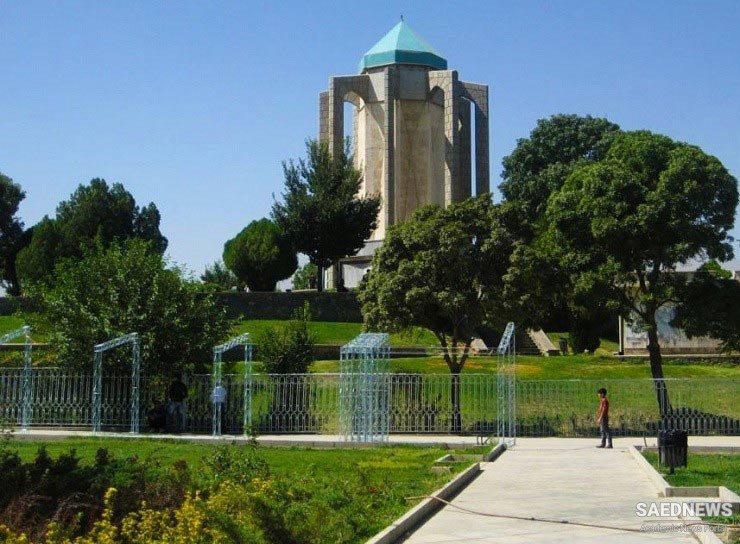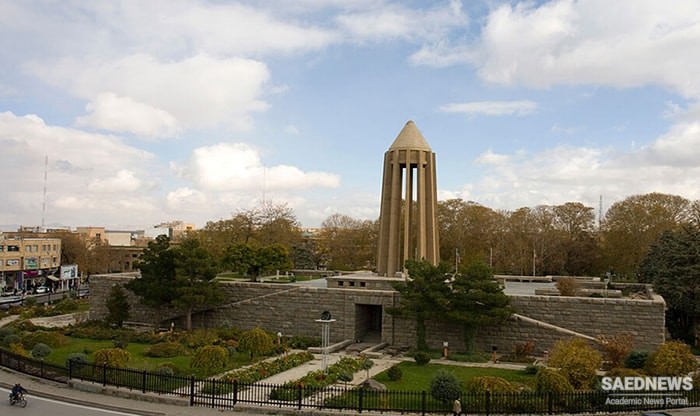Baba Tahir (var. Baba Taher Oryan Hamadani; Persian: باباطاهر ) was an 11th-century Persian poet. His poetry is written in Hamedani dialect of Persian language. According to L. P. Elwell-Sutton he probably wrote in the local dialect, which "Most traditional sources call it loosely Luri, while the name commonly applied from an early date to verses of this kind, Fahlaviyat, presumably implies that they were thought to be in a language related to the Middle Iranian dialect Pahlavi. Rouben Abrahamian however found a close affinity with the dialect spoken at the present time by the Jews of Hamadan.According to The Cambridge History of Iran, Baba Tahir spoke a certain Persian dialect.
Baba Taher Oryan Mausoleum is based on an Octagonal form. The dimension of the mausoleum is 10 x 10 Meters and it is surrounded with prism forms. It has 8 columns around the main building. The material of the columns, stairs, grave stone, and surface of the mausoleum is Granite stone. It has beautiful Turquoise dome-shaped prism. Inside of the Mausoleum, there are 24 Couplet poems carvings on 24 Marmori stone plates and has magnificent motifs tile decoration under the ceiling.
The Mausoleum had been registered as one of Iranian National Monuments in May 11, 1997 by Registration No. 1870.
The modern tomb of the mystic poet Baba Taher was previously in a ruined tower on a hilltop in the northwestern outskirts of the city. It was replaced by a modern one that imitates that of Ebn Sina. An inscription in Kufic script belonging to the 13th century was found in the tomb tower at the time of its replacement by the modern one.
Baba Tahir mausoleum (photo below) situated near the northern entrance of the city of Hamadan. It was reconstructed in 1970. Baba Tahir, living in the first half of the 11th centuray A.D.
Baba Tahir is known as one of the most revered and respectable early poets in Persian literature. Most of his life is clouded in mystery. He was born and lived in Hamadan, the capital city of the Hamedan Province in Iran. He was known by the name of Baba Taher-e Oryan (The Naked), which suggests that he may have been a wandering dervish. Legend tells that the poet, an illiterate woodcutter, attended lectures at a religious school, where he was not welcomed by his fellow-students. The dates of his birth and death are unknown. One source indicates that he died in 1019. If this is accurate, it would make Baba Tahir a contemporary of Ferdowsi and Pour Sina (Avicenna) and an immediate precursor of Omar Khayyam. Another source reports that he lived between 1000 and 1055, which is most unlikely. Reliable research notes speculate that Baba Tahir lived for seventy-five years. Rahat al-sodur of Ravandi (completed 603/1206), describes a meeting between Baba Tahir, and the Saljuq conqueror Togrel . According to L. P. Elwell-Sutton: He could be described as the first great poet of Sufi love in Persian literature. In the last two decades his do-baytis have often been put to music.
Address: Google Map



 Iran National Museum: the Witness to the Greatness of Ancient Persian Civilization
Iran National Museum: the Witness to the Greatness of Ancient Persian Civilization














































